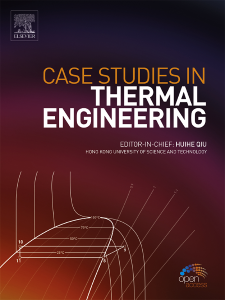Interpretable machine learning study of a collector based on combined twisted-tape and wavy-tape inserts
IF 6.4
2区 工程技术
Q1 THERMODYNAMICS
引用次数: 0
Abstract
Nowadays, the efficiency of air collectors for solar thermal applications is still low, and many researchers tend to use machine learning to predict and model the performance of thermal systems, but most of the existing machine learning methods are uninterpretable, which poses a challenge for machine learning applications. In this paper, a new collector insert with enhanced heat transfer in the form of a combination of wave and helical twisted bands is firstly designed for performance test experiments using solar air collectors. Then, based on the test data, three mutually interpretable machine learning methods, PDP, ALE, and SHAP, are explored for predictive studies of collector performance. The results show that the average efficiency of the collector with inserted structure increases by 19.71 %, 12.25 %, and 17.53 % at inlet flow rates of 2.1 m/s, 3.3 m/s, and 4.5 m/s, respectively. The highest collector efficiency was achieved with a wave plate length of 360 mm, a helical twist ratio of 5.14, and an inlet flow rate of 4.5 m/s. Understanding how much the input affects the output through the interpretability of SHAP proves the value of interpretable machine learning, which is useful in guiding the modification of the collector structure.
基于扭曲带和波浪带组合插入式采集器的可解释机器学习研究
目前,太阳能热应用中空气集热器的效率仍然较低,许多研究人员倾向于使用机器学习来预测热系统的性能并建立模型,但现有的机器学习方法大多无法解读,这给机器学习的应用带来了挑战。本文首先利用太阳能空气集热器设计了一种具有增强传热性能的新型集热器插件,其形式为波浪带和螺旋扭曲带的组合,并进行了性能测试实验。然后,根据测试数据,探索了三种可相互解释的机器学习方法,即 PDP、ALE 和 SHAP,用于集热器性能的预测研究。结果表明,当入口流速为 2.1 米/秒、3.3 米/秒和 4.5 米/秒时,采用插入式结构的集热器的平均效率分别提高了 19.71%、12.25% 和 17.53%。波板长度为 360 毫米、螺旋扭曲比为 5.14、入口流速为 4.5 米/秒时,集热器效率最高。通过 SHAP 的可解释性了解输入对输出的影响程度,证明了可解释机器学习的价值,有助于指导集热器结构的修改。
本文章由计算机程序翻译,如有差异,请以英文原文为准。
求助全文
约1分钟内获得全文
求助全文
来源期刊

Case Studies in Thermal Engineering
Chemical Engineering-Fluid Flow and Transfer Processes
CiteScore
8.60
自引率
11.80%
发文量
812
审稿时长
76 days
期刊介绍:
Case Studies in Thermal Engineering provides a forum for the rapid publication of short, structured Case Studies in Thermal Engineering and related Short Communications. It provides an essential compendium of case studies for researchers and practitioners in the field of thermal engineering and others who are interested in aspects of thermal engineering cases that could affect other engineering processes. The journal not only publishes new and novel case studies, but also provides a forum for the publication of high quality descriptions of classic thermal engineering problems. The scope of the journal includes case studies of thermal engineering problems in components, devices and systems using existing experimental and numerical techniques in the areas of mechanical, aerospace, chemical, medical, thermal management for electronics, heat exchangers, regeneration, solar thermal energy, thermal storage, building energy conservation, and power generation. Case studies of thermal problems in other areas will also be considered.
 求助内容:
求助内容: 应助结果提醒方式:
应助结果提醒方式:


